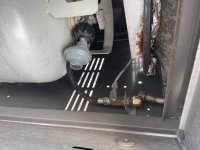In 22 I bought myself a treat and bought a Genesis SE EPX 335. I absolutely love this grill and don’t regret the sticker shock quite as much anymore. However life changes and so did our house. I now have access to natural gas. I do not want to cut any corners or do anything dangerous. I have read through every thread on the topic that I could find. I plan on changing the manifold as it seems the preferred method. However I can’t seem to find any information on what’s involved with the side burner.
For the manifold I have found part number 64606 to replace the propane version.
https://www.grillspot.ca/weber-oem-natural-gas-manifold-assembly-64606
For the side burner would I need part 64991 which is the entire ng side burner assembly?
https://www.grillspot.ca/weber-oem-natural-gas-side-burner-assembly-64991
Would this be what I need to do a safe conversion?
Thank you.
For the manifold I have found part number 64606 to replace the propane version.
https://www.grillspot.ca/weber-oem-natural-gas-manifold-assembly-64606
For the side burner would I need part 64991 which is the entire ng side burner assembly?
https://www.grillspot.ca/weber-oem-natural-gas-side-burner-assembly-64991
Would this be what I need to do a safe conversion?
Thank you.

